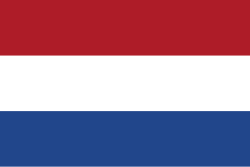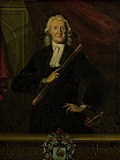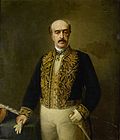| History of Indonesia |
|---|
 |
| Timeline |
This is a list of governors and colonial administrators of the Dutch East Indies. [1] [2]
Contents
- Governors
- Dutch East India Company rule
- Dutch government rule
- See also
- Footnotes
- Sources
- External links




| History of Indonesia |
|---|
 |
| Timeline |
This is a list of governors and colonial administrators of the Dutch East Indies. [1] [2]




| | ||||
|---|---|---|---|---|
| No. | Portrait | Name | Took office | Left office |
| 1 |  | Pieter Both (1568–1615) | 19 December 1610 | 6 November 1614 |
| 2 |  | Gerard Reynst (1568–1615) | 6 November 1614 | 7 December 1615 |
| 3 |  | Laurens Reael (1583–1637) | 7 December 1615 | 21 March 1619 |
| 4 |  | Jan Pieterszoon Coen (1587–1629) | 30 April 1618 | 1 February 1623 |
| 5 |  | Pieter de Carpentier (1586–1659) | 1 February 1623 | 30 September 1627 |
| 6 |  | Jan Pieterszoon Coen (1587–1629) | 30 September 1627 | 21 September 1629 |
| 7 |  | Jacques Specx (1585–1652) | 22 September 1629 | 17 April 1632 |
| 8 |  | Hendrik Brouwer (1581–1643) | 18 April 1632 | 1 January 1636 |
| 9 |  | Anthony van Diemen (1593–1645) | 1 January 1636 | 19 April 1645 |
| 10 |  | Cornelis van der Lijn (1608–1679) | 19 April 1645 | 26 April 1650 |
| 11 |  | Carel Reyniersz (1604–1653) | 26 April 1650 | 19 May 1653 |
| 12 |  | Joan Maetsuycker (1606–1678) | 19 May 1653 | 4 January 1678 |
| 13 |  | Rijckloff van Goens (1619–1682) | 4 January 1678 | 25 November 1681 |
| 14 |  | Cornelis Speelman (1628–1684) | 25 November 1681 | 11 January 1684 |
| 15 |  | Johannes Camphuys (1634–1695) | 11 January 1684 | 24 November 1691 |
| 16 |  | Willem van Outhoorn (1635–1720) | 24 September 1691 | 15 August 1704 |
| 17 |  | Joan van Hoorn (1653–1711) | 15 August 1704 | 30 October 1709 |
| 18 |  | Abraham van Riebeeck (1653–1713) | 30 October 1709 | 17 November 1713 |
| 19 |  | Christoffel van Swoll (1668–1718) | 17 November 1713 | 12 November 1718 |
| 20 |  | Hendrick Zwaardecroon (1667–1728) | 13 November 1718 | 8 July 1725 |
| 21 |  | Mattheus de Haan (1663–1729) | 8 July 1725 | 1 June 1729 |
| 22 |  | Diederik Durven (1676–1740) | 1 June 1729 | 28 May 1732 |
| 23 |  | Dirck van Cloon (1684–1735) | 28 May 1732 | 10 March 1735 |
| 24 |  | Abraham Patras (1671–1737) | 11 March 1735 | 3 May 1737 |
| 25 |  | Adriaan Valckenier (1691–1751) | 3 May 1737 | 6 November 1741 |
| 26 |  | Johannes Thedens (1680–1748) | 6 November 1741 | 28 May 1743 |
| 27 |  | Gustaaf Willem van Imhoff (1705–1750) | 28 May 1743 | 1 November 1750 |
| 28 |  | Jacob Mossel (1704–1761) | 1 November 1750 | 15 May 1761 |
| 29 |  | Petrus Albertus van der Parra (1714–1775) | 15 May 1761 | 28 December 1775 |
| 30 |  | Jeremias van Riemsdijk (1712–1777) | 28 December 1775 | 3 October 1777 |
| 31 |  | Reynier de Klerck (1710–1780) | 4 October 1777 | 1 September 1780 |
| 32 |  | Willem Arnold Alting (1724–1800) | 1 September 1780 | 17 February 1797 |
| | |||||
|---|---|---|---|---|---|
| No. | Portrait | Name | Took office | Left office | Monarch |
| 1 |  | Pieter Gerardus van Overstraten (1755–1801) | 16 August 1796 | 22 August 1801 |  Batavian Republic (19 January 1795 – 5 June 1806) |
| 2 |  | Johannes Siberg (1740–1817) | 22 August 1801 | 19 October 1804 | |
| 3 |  | Albertus Henricus Wiese (1761–1810) | 19 October 1804 | 5 June 1806 | |
| French interregnum in the Dutch East Indies under the Kingdom of Holland | |||||
| 3 |  | Albertus Henricus Wiese (1761–1810) | 5 June 1806 | 14 January 1808 |  Lodewijk I (5 June 1806 – 1 July 1810) House of Bonaparte |
| 4 |  | Herman Willem Daendels (1762–1818) | 14 January 1808 | 15 May 1811 | |
 Lodewijk II (1 July 1810 – 9 July 1810) House of Bonaparte | |||||
| 5 |  | Jan Willem Janssens (1762–1838) | 15 May 1811 | 18 September 1811 |  Napoleon I (9 July 1810 – 18 September 1811) House of Bonaparte |
| British interregnum in the Dutch East Indies | |||||
| — |  | Robert Rollo Gillespie (1766–1814) Acting Governor | 9 August 1811 | 18 September 1811 |  George III (9 August 1811 – 19 August 1816) House of Hanover |
| 6 |  | Thomas Stamford Raffles (1781–1826) | 18 September 1811 | 12 March 1816 | |
| 7 |  | John Fendall (1762–1825) | 12 March 1816 | 19 August 1816 | |
| Netherlands regained full control with three commissioners-general | |||||
| 8 |  | Cornelis Theodorus Elout (1767–1841) | 19 August 1816 | 16 January 1819 |  Willem I (19 August 1816 – 16 January 1819) House of Orange-Nassau |
 | Godert van der Capellen (1778–1848) | ||||
 | Arnold Adriaan Buyskes (1771–1838) | ||||
| Cornelis Theodorus Elout and Arnold Adriaan Buyskes left | |||||
| 9 |  | Godert van der Capellen (1778–1848) | 16 January 1819 | 1 January 1826 |  Willem I (16 January 1819 – 7 October 1840) House of Orange-Nassau |
| 10 |  | Leonard du Bus de Gisignies (1780–1849) De Jure Governor-General | 2 January 1826 | 16 January 1830 | |
 | Hendrik Merkus de Kock (1779–1845) Lieutenant Governor-General | ||||
| 11 |  | Johannes van den Bosch (1780–1844) | 16 January 1830 | 2 July 1833 | |
| 12 |  | Jean Chrétien Baud (1789–1859) | 2 July 1833 | 29 February 1836 | |
| 13 |  | Dominique Jacques de Eerens (1781–1840) | 29 February 1836 | 30 May 1840 | |
| — |  | Carel van Hogendorp (1788–1856) Acting Governor-General | 30 May 1840 | 6 January 1841 | |
| 14 |  | Pieter Merkus (1787–1844) | 6 January 1841 | 2 August 1844 |  Willem II (7 October 1840 – 17 March 1849) House of Orange-Nassau |
| — |  | Joan Cornelis Reynst (1798–1871) Acting Governor-General | 2 August 1844 | 30 September 1845 | |
| 15 |  | Jan Jacob Rochussen (1797–1871) | 30 September 1845 | 12 May 1851 | |
| 16 |  | Albertus Duymaer van Twist (1809–1887) | 15 May 1851 | 22 May 1856 |  Willem III (17 March 1849 – 23 November 1890) House of Orange-Nassau |
| 17 |  | Charles Ferdinand Pahud (1803–1873) | 22 May 1856 | 2 September 1861 | |
| — |  | Ary Prins (1816–1867) Acting Governor-General | 2 September 1861 | 19 October 1861 | |
| 18 |  | Ludolph Sloet van de Beele (1806–1890) | 19 October 1861 | 25 October 1866 | |
| — |  | Ary Prins (1816–1867) Acting Governor-General | 25 October 1866 | 28 December 1866 | |
| 19 |  | Pieter Mijer (1812–1881) | 28 December 1866 | 1 January 1872 | |
| 20 |  | James Loudon (1824–1900) | 1 January 1872 | 26 March 1875 | |
| 21 |  | Johan Wilhelm van Lansberge (1830–1905) | 26 March 1875 | 12 April 1881 | |
| 22 |  | Frederik s'Jacob (1822–1901) | 12 April 1881 | 20 January 1884 | |
| 23 |  | Otto van Rees (1823–1892) | 20 January 1884 | 29 September 1888 | |
| 24 |  | Cornelis Pijnacker Hordijk (1847–1908) | 29 September 1888 | 17 October 1893 | |
| 25 |  | Carel Aart van der Wijck (1840–1914) | 17 October 1893 | 3 October 1899 |  Wilhelmina (23 November 1890 – 8 March 1942) House of Orange-Nassau |
| 26 |  | Willem Rooseboom (1843–1920) | 3 October 1899 | 1 October 1904 | |
| 27 |  | Johannes van Heutsz (1851–1924) | 1 October 1904 | 18 December 1909 | |
| 28 |  | Alexander Idenburg (1861–1935) | 18 December 1909 | 21 March 1916 | |
| 29 |  | Johan Paul van Limburg Stirum (1873–1948) | 21 March 1916 | 24 March 1921 | |
| 30 |  | Dirk Fock (1858–1941) | 24 March 1921 | 6 September 1926 | |
| 31 |  | Andries Cornelis Dirk de Graeff (1872–1957) | 6 September 1926 | 11 September 1931 | |
| 32 |  | Bonifacius Cornelis de Jonge (1875–1958) | 12 September 1931 | 16 September 1936 | |
| 33 |  | Alidius Tjarda van Starkenborgh (1888–1978) | 16 September 1936 | 8 March 1942 | |
| Japanese occupation and Indonesian National Revolution | |||||
| — |  | Hubertus Johannes van Mook (1894–1965) Lieutenant Governor-General | 8 March 1942 | 15 October 1948 |  Wilhelmina (8 March 1942 – 4 September 1948) House of Orange-Nassau |
| — |  | Louis Joseph Maria Beel (1902–1977) High Representative of the Crown | 29 October 1948 | 18 May 1949 |  Juliana (4 September 1948 – 27 December 1949) House of Orange-Nassau |
| — |  | Antonius Hermanus Lovink (1902–1995) High Representative of the Crown | 18 May 1949 | 27 December 1949 | |
| Establishment of the Netherlands-Indonesia Union | |||||
| — |  | Petrus Johannes Idenburg (1896–1976) Director General of General Affairs | 27 December 1949 | 15 February 1956 |  Juliana (27 December 1949 – 15 February 1956) House of Orange-Nassau |